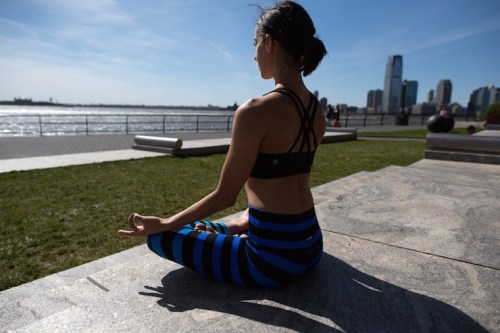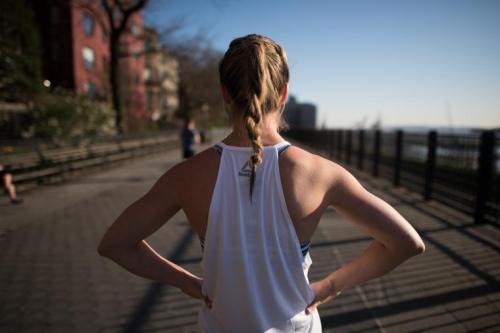Music and cardio go together like avocado and toast. It’s a powerful combo that ignites the happy part of your brain. And these days, it seems like every fitness studio has built its classes around a playlist. Heart rates are timed to the beats per minute of a song, spin classes line-up their super-intense moves along with crescendos, and there are even workout apps that acts as portable DJ for your HIIT routines.
But there’s a problem: Admit it—music is a crutch. Ever go to the gym, notice your phone is at 2 percent, and decide to skip a workout that day? Or what happens when you’re out running in the woods and there’s no wifi, so you can’t connect to Spotify? Whatever the cause, sometimes music just isn’t there for you when you need it. And then what?
Ryan McCann, an instructor at Mile High Run Club and the founder of Cool Fit Club, has never relied on music to get him through a workout. When asked for tips on how he does it, he explained that not listening to music during an aerobic activity can actually make you a better athlete and the overall experience more enjoyable.
If that claim just made you spit out your organic Gatorade, you’ll definitely want to keep reading for his intel.
Here are McCann’s five tips for ditching the music crutch and working out without music.

1. Work out with a friend
The easiest way to leave your headphones behind after you lace up your sneakers? Work out with a friend or group. “It builds a personal connection and feeling of being a part of something bigger than yourself,” McCann says. Also, listening to your friend tell you about the terrible Tinder date she went on the other night will keep you from missing Beyonce in your ear. Bonus points: You have someone who will hold you accountable for actually getting out there.

2. Do a mental checklist
Okay, now comes the hard part: doing it alone. For McCann, it’s all about focusing on two things: biomechanics and breathing. “It’s a lot more sophisticated than people think,” he says. “If you don’t have your form and breathing down, you’re never going to feel comfortable, and if you don’t feel comfortable, that’s when you’re forced to find crutches like music or an expensive group class.”
If you’re a runner, here are the checkpoints McCann says to continuously loop through: “Run tall, as if someone is pulling you up through the crown of your head, lifting you up and straightening your spine out. Second, run with your core, flexing your abs, which keeps you centered and your stride more efficient. And third, scan your body from top to bottom, making sure you’re staring straight ahead, your jaw and shoulders are relaxed, and your knees are soft so you’re landing light on your feet.”
McCann says when his posture changes, like when he gets tired and his shoulders slightly hunch forward, he can catch it in seconds and correct it because there’s nothing else distracting him. The same goes for whatever cardio sport you’re into—constantly zeroing in on your form leads to fewer mistakes. It’s easier to heighten your awareness if you’re not distracted by Frank Ocean’s lyrics.

3. Focus on your breathing
Breath is another thing McCann is always aware of during a workout—it helps him figure out how his body is feeling and what effort to put forth. “If you charge up a hill and you’re really winded, it’s wiser to walk instead of powering through,” he says. “Listen to your body and run based on how you feel, and manage your run based on that throughout the duration. It will set your pace and intensity.”
If you’re too busy jamming out to notice how your body is feeling, you may put in too much effort early on—and ignoring signs your body is giving you—which means you won’t be able to finish as strong.

4. Meditate beforehand
McCann is a strong believer in focus before fitness. It’s why he leads meditation before group runs or swims with Cool Runners Club and Cool Swimmers Club. “When you meditate, you light up the neurogenesis in the prefrontal cortex, which is critical for concentration,” he explains. “And when we do aerobic exercise, we generate neurons in the hippocampus, which is critical for memory. So when you meditate before working out, you really tap into the focus zone and increase that level of concentration before you go out there and test your legs and lungs. Then muscle memory sets in the next time you do it, making everything more comfortable and more enjoyable.” Simply put: Meditation makes your workouts easier.

5. Take in your surroundings
If you’re working out sans music—whether that’s going for a bike ride, a jog, or even just a walk—chances are you’re outside. So why not take a look around? McCann often runs the New York City streets and says he’s come to love a particular curve on Gay Street—something he probably would have missed if he was wearing headphones. But now he looks forward to that part of his run every time. “The sensory experience we all have and the overall enjoyment depends on the surroundings,” he says. “Work out where you’re happiest. Then, it doesn’t feel as hard anymore.”
Want more tips on being at the top of your running game? Don’t fall for these common myths. And meditation doesn’t just lead to a better workout—it’s linked to better sex, too.
Sign Up for Our Daily Newsletter
Get all the latest in wellness, trends, food, fitness, beauty, and more delivered right to your inbox.
Got it, you've been added to our email list.










